A Comprehensive Review of Industrial Workshop Oil Mist Control Technology Based on Electrostatic Collection
Abstract
:1. Introduction
2. Oli Mist Generation Mechanism
3. Oil Mist Occupational Exposure Limits
| Organization | Years | Nation | Exposure Limit | Liquid Type | Particle Size |
|---|---|---|---|---|---|
| ACGIH [42] | 1964–2008 | USA | TWA 5 mg/m3 STEL 10 mg/m3 | Oil mist | All ranges |
| 2008–2009 | TWA 5 mg/m3, STEL 10 mg/m3 | Oil mist Withdrawal adopted | All ranges | ||
| 2001–2005 | TWA 0.2 mg/m3 (NIC) | Mineral oil | Inhalable | ||
| 2006–2008 | TWA 0.2 mg/m3 (NIC) | Mineral oils for metalworking | Inhalable | ||
| 2009–2010 | TWA 5 mg/m3 (NIC) | Refined mineral oil | Inhalable | ||
| 2010–2011 | TWA 5 mg/m3 | Mineral oils, excluding MWF | Inhalable | ||
| 2001–2008 | A2 (NIC) | Mineral oil used in metalworking–poorly and mildly refined mineral oil | NA | ||
| 2009 | A2 (NIC) | Mineral oil–poorly and mildly refined mineral oil | NA | ||
| 2010–2011 | A2 | Mineral oil, excluding MWF–poorly and mildly refined mineral oil | NA | ||
| OSHA [43] | 1964–2007 | USA | TWA 5 mg/m3 STEL 10 mg/m3 | Mineral oil | All ranges |
| 1998 | REL 0.5 mg/m3 | All types | All ranges | ||
| NIOSH [44] | <1998 | USA | TWA 5 mg/m3 STEL 10 mg/m3 | NI | All ranges |
| 1998 | REL 0.5 mg/m3 | All types | All ranges | ||
| REL 0. 4 mg/m3 | All types | Thoracic | |||
| Japan Occupational Health Association (JOSH) [45] | 1996 | Japan/Finland/Sweden | TLV-TWA 0.3 mg/m3 | Cutting fluid mist | All ranges |
| UK Health and Safety Executive(HSE) [46] | 1990–2007 | U.K. | TWA 5 mg/m3 STEL 10 mg/m3 | Oil mist | All ranges |
| 2002 | ACTS guidance values TWA 3 mg/m TWA 1 mg/m3 | Oil-based (neat oil) Water-soluble | Inhalable Inhalable |
4. Oil Mist Monitor Technology
5. Electrostatic Collection Technology for Oil Mist
5.1. Principle of Electrostatic Collection Technology
5.2. Oil Mist Deposition Characteristics
5.3. Two-Stage Electrostatic Collection
5.4. The Practical Application Significance of the ESP
6. Conclusions
- In actual processing workshops, continuous production by equipment leads to severe oil mist pollution, and many factories still exceed the NIOSH limit of 0.5 mg/m3. In these processing workshops, efficient electrostatic oil mist collection methods and collaborative purification strategies therefore require further research.
- During cutting and milling, the coolant flow rate is the primary parameter affecting the amount of oil mist emitted. Compared to spray lubrication, the minimum quantity lubrication (MQL) mode generates a larger number of oil mist particles. Thus, while MQL largely reduces coolant consumption, it can be more detrimental to air quality. When selecting purification control technologies, both the characteristics of the oil mist and the process requirements should be considered.
- Electrostatic deposition is an effective method for oil mist purification, and the two-stage ESP has become the mainstream equipment for oil mist purification in workshops due to its dust collection area, which can be expanded by using smaller plate spacing. However, the impact of particle size distribution on deposition characteristics requires further investigation. Additionally, most current studies on the particle deposition characteristics of ESPs are conducted in single-stage systems, and the deposition characteristics of particles in two-stage ESPs need further exploration.
- The oil mist collection efficiency of the electrostatic collection method is influenced by the combined effects of multiple physical fields. Studying the coupling effects of factors such as inlet airflow characteristics, applied voltage, and air environment, and optimizing the electrostatic precipitator’s collection efficiency based on these factors, may lead to better optimization results.
- Optimizing the structural design and parameters of the two-stage ESP (such as electrode plate distance, voltage, electrode plate, and material) can improve the oil mist particle collection efficiency and reduce secondary escape. This is an effective strategy for enhancing efficiency, and the impact of relevant parameters still requires further systematic study.
- The oil mist deposition characteristics are complex and directly impact collection efficiency. Future research aimed at improving oil mist collection efficiency must consider factors such as inlet airflow characteristics, applied voltage, and the air environment. Precise regulation is required to reduce the oil film thickness during ESP operation and enhance collection efficiency. Moreover, AI algorithms have enormous potential in the field of oil mist control. They can analyze oil mist data, dynamically adjust equipment parameters to improve purification efficiency, predict equipment failures based on operational parameters, and, when integrated with the IoT, enable equipment collaboration and data sharing. This provides a smarter and more efficient solution for oil mist control.
Author Contributions
Funding
Institutional Review Board Statement
Informed Consent Statement
Data Availability Statement
Conflicts of Interest
References
- Yue, Y.; Sun, J.; Gunter, K.; Michalek, D.; Sutherland, J. Character and behavior of mist generated by application of cutting fluid to a rotating cylindrical workpiece, part 1: Model development. J. Manuf. Sci. Eng. 2004, 126, 417–425. [Google Scholar] [CrossRef]
- Zhang, Y.; Yang, Y.; Cao, Q.; Wang, Y.; Fan, J.-N.; Chen, H.; Wang, X.; Wang, F.; Zhou, Y.; Quan, M. Distribution of oil mist particles and air quality improvement in the working area of the cutting workshop. J. Hazard. Mater. 2024, 480, 135812. [Google Scholar] [CrossRef] [PubMed]
- Wang, X.; Zhou, Y.; Wang, F.; Jiang, X.; Yang, Y. Exposure levels of oil mist particles under different ventilation strategies in industrial workshops. Build. Environ. 2021, 206, 108264. [Google Scholar] [CrossRef]
- Chen, Y.-C.; Lin, C.-H.; Lung, S.-C.C.; Chen, K.-F.; Wang, W.-C.V.; Chou, C.-T.; Lai, C.-H. Environmental concentration of spray paint particulate matters causes pulmonary dysfunction in human normal bronchial epithelial BEAS-2B cell. Process Saf. Environ. Prot. 2019, 126, 250–258. [Google Scholar] [CrossRef]
- Zhang, J.; Long, Z.; Liu, W.; Chen, Q. Strategy for Studying Ventilation Performance in Factories. Aerosol Air Qual. Res. 2016, 16, 442–452. [Google Scholar] [CrossRef]
- Lotrecchiano, N.; Montano, L.; Bonapace, I.M.; Giancarlo, T.; Trucillo, P.; Sofia, D. Comparison Process of Blood Heavy Metals Absorption Linked to Measured Air Quality Data in Areas with High and Low Environmental Impact. Processes 2022, 10, 1409. [Google Scholar] [CrossRef]
- Fu, S.; Zhou, W.; Yan, L.; Zhang, Z.; Zou, H. The actuality and development of metalworking fluids (MWFS) mist control. Lubr. Oil 2003, 6, 1–5. [Google Scholar]
- Zhang, J.; Shao, Y.; Long, Z. Physicochemical characterization of oily particles emitted from different machining processes. J. Aerosol Sci. 2016, 96, 1–13. [Google Scholar] [CrossRef]
- Wang, F.; Wu, Z.; Jiang, X.; Zhou, Y.; Wang, X.; Song, B.; Shao, M. Field measurement of oil mist particle concentration distribution in machining workshops. Heat. Vent. Air Cond. 2022, 49, 130–137. [Google Scholar]
- Guan, B.; Zhan, R.; Lin, H.; Huang, Z. Review of the state-of-the-art of exhaust particulate filter technology in internal combustion engines. J. Environ. Manag. 2015, 154, 225–258. [Google Scholar] [CrossRef]
- Sajeesh, P.; Sen, A.K. Particle separation and sorting in microfluidic devices: A review. Microfluid. Nanofluidics 2014, 17, 1–52. [Google Scholar] [CrossRef]
- Dong, M.; Zhou, F.; Zhang, Y.; Shang, Y.; Li, S. Numerical study on fine-particle charging and transport behaviour in electrostatic precipitators. Powder Technol. 2018, 330, 210–218. [Google Scholar] [CrossRef]
- Hua, Y.; Cui, P.; Liu, J. Research on Electrostatic Purification Equipment Suitable for High-concentration Oil Mist Exhaust Gas. Guangdong Chem. Ind. 2022, 49, 115–117. (In Chinese) [Google Scholar]
- Li, Y.; Xu, X.; Zhang, H.; Li, R.; Tian, A. Numerical Simulation of Dual-Zone Electrostatic Oil Mist Purifier. SSRN 2014, 4715148. [Google Scholar] [CrossRef]
- Gao, M.; Yao, X.; Zhu, Y.; Zhang, Y.; Shi, J.; Shangguan, W. Numerical simulation study of two-stage electrostatic precipitator. China Environ. Sci. 2018, 38, 3698–3703. (In Chinese) [Google Scholar]
- Wang, X.; You, C. Effect of humidity on negative corona discharge of electrostatic precipitators. IEEE Trans. Dielectr. Electr. Insul. 2013, 20, 1720–1726. [Google Scholar] [CrossRef]
- Zhang, S.S.; Liu, Q.; Chen, J.P. Numerical analysis of charged particle collection in wire-plate ESP. J. Electrost. 2015, 74, 56–65. [Google Scholar]
- Said, H.A.; Aissou, M.; Nouri, H.; Zebboudj, Y. Analysis of the Current-Voltage Characteristic during the Corona Discharge in Wires-To-Planes Electrostatic Precipitator under Variable Air Humidity. Acta Phys. Pol. A 2019, 135, 320–325. [Google Scholar] [CrossRef]
- Li, J.; Liu, S. Numerical Simulation and Structure Optimization of Electrostatic Precipitator. CFHI Technol. 2019, 50–54. (In Chinese) [Google Scholar] [CrossRef]
- Yang, X.; Kang, Y.; Zhong, K. Performances of Double-Stage Electrostatic Air Cleaners. Trans. Beijing Inst. Technol. 2005, 25, 149–152. (In Chinese) [Google Scholar]
- Long, Z.; Wang, Y.; Li, S.; Zhang, H.; Cheng, X. Monitoring and purification of oil mist particles in a machining workshop. Heat. Vent. Air Cond. 2019, 49, 50–55. [Google Scholar]
- Yang, Y.; Chen, H.; Cao, Q.; Qiao, M.; Wang, Y.; Fan, J.-N.; Yang, C.; Pan, B.; Wang, X.; Wang, F. Purification technology of oil mist in industrial buildings: A review. Build. Environ. 2023, 235, 110229. [Google Scholar] [CrossRef]
- Zhao, X.; Yin, Y. Hazards of pollutants and ventilation control strategy in industrial workshops: Current state and future trend. Build. Environ. 2024, 251, 111229. [Google Scholar] [CrossRef]
- Raynor, P.C.; Kim, S.W.; Bhattacharya, M. Mist generation from metalworking fluids formulated using vegetable oils. Ann. Occup. Hyg. 2005, 49, 283–293. [Google Scholar]
- Sheng, P.; Oberwalleney, S. Life-cycle planning of cutting fluids—A review. J. Manuf. Sci. Eng. 1997, 119, 791–800. [Google Scholar] [CrossRef]
- Wang, Y.; Murga, A.; Long, Z.; Yoo, S.; Ito, K. Experimental study of oil mist characteristics generated from minimum quantity lubrication and flood cooling. Energy Built Environ. 2021, 2, 45–55. [Google Scholar] [CrossRef]
- Michalek, D.J.; Hii, W.W.-S.; Sun, J.; Gunter, K.L.; Sutherland, J.W. Experimental and analytical efforts to characterize cutting fluid mist formation and behavior in machining. Appl. Occup. Environ. Hyg. 2003, 18, 842–854. [Google Scholar] [CrossRef]
- Li, Y.; Zong, S.; Jing, H.; Gao, N.; Ye, H.; Chen, J. The influence of ventilation modes on oil mist particles diffusion in a machining workshop. Heliyon 2024, 10, e26963. [Google Scholar] [CrossRef]
- Lefebvre, A.H.; McDonell, V.G. Atomization and Sprays; CRC Press: Boca Raton, FL, USA, 2017. [Google Scholar]
- Macıas-Garcıa, A.; Cuerda-Correa, E.M.; Dıaz-Dıez, M. Application of the Rosin–Rammler and Gates–Gaudin–Schuhmann models to the particle size distribution analysis of agglomerated cork. Mater. Charact. 2004, 52, 159–164. [Google Scholar] [CrossRef]
- D’arcy, J.; Dasch, J.; Gundrum, A.; Rivera, J.; Johnson, J.; Carlson, D.; Sutherland, J. Characterization of process air emissions in automotive production plants. J. Occup. Environ. Hyg. 2016, 13, 9–18. [Google Scholar] [CrossRef]
- Gao, J.; Cao, C.; Zhang, X.; Luo, Z. Volume-based size distribution of accumulation and coarse particles (PM0.1–10) from cooking fume during oil heating. Build. Environ. 2013, 59, 575–580. [Google Scholar] [CrossRef]
- Khettabi, R.; Nouioua, M.; Djebara, A.; Songmene, V. Effect of MQL and dry processes on the particle emission and part quality during milling of aluminum alloys. Int. J. Adv. Manuf. Technol. 2017, 92, 2593–2598. [Google Scholar] [CrossRef]
- Maruda, R.W.; Krolczyk, G.M.; Feldshtein, E.; Pusavec, F.; Szydlowski, M.; Legutko, S.; Sobczak-Kupiec, A. A study on droplets sizes, their distribution and heat exchange for minimum quantity cooling lubrication (MQCL). Int. J. Mach. Tools Manuf. 2016, 100, 81–92. [Google Scholar] [CrossRef]
- Brody, A.R.; Roe, M.W.; Evans, J.N.; Davis, G.S. Deposition and translocation of inhaled silica in rats. Quantification of particle distribution, macrophage participation, and function. Lab. Investig. J. Tech. Methods 1982, 47, 533. [Google Scholar]
- Lai, C.-H.; Chen, Y.-C.; Lin, K.-Y.A.; Lin, Y.-X.; Lee, T.-H.; Lin, C.-H. Adverse pulmonary impacts of environmental concentrations of oil mist particulate matter in normal human bronchial epithelial cell. Sci. Total Environ. 2022, 809, 151119. [Google Scholar] [CrossRef]
- Wang, Y.; Guo, Y.; Hao, W.; Liu, W.; Long, Z. Simulation study of the purification system for indoor oil mist control in machining factories. Build. Simul. 2023, 16, 1361–1374. [Google Scholar] [CrossRef]
- Nie, H.; Liu, H.; Shi, Y.; Lai, W.; Liu, X.; Xi, Z.; Lin, B. Combined multi-omics analysis reveals oil mist particulate matter-induced lung injury in rats: Pathological damage, proteomics, metabolic disturbances, and lung dysbiosis. Ecotoxicol. Environ. Saf. 2022, 241, 113759. [Google Scholar] [CrossRef]
- Wang, Y.; Shen, X.; Yoo, S.-J.; Long, Z.; Ito, K. Error analysis of human inhalation exposure simulation in industrial workshop. Build. Environ. 2022, 224, 109573. [Google Scholar] [CrossRef]
- Simpson, A.; Stear, M.; Groves, J.; Piney, M.; Bradley, S.; Stagg, S.; Crook, B. Occupational exposure to metalworking fluid mist and sump fluid contaminants. Ann. Occup. Hyg. 2003, 47, 17–30. [Google Scholar]
- Wang, F.; Li, Z.; Wang, P.; Zhang, R. Experimental study of oil particle emission rate and size distribution during milling. Aerosol Sci. Technol. 2018, 52, 1308–1319. [Google Scholar] [CrossRef]
- American Conference of Governmental Industrial Hygienists. Threshold Limit Values for Chemical Substances and Physical Agents and Biological Exposure Indices; American Conference of Governmental Industrial Hygienists: Washington, DC, USA, 1995. [Google Scholar]
- Rosner, D.; Markowitz, G. A short history of occupational safety and health in the United States. Am. J. Public Health 2020, 110, 622–628. [Google Scholar] [CrossRef] [PubMed]
- Mirer, F.E. New evidence on the health hazards and control of metalworking fluids since completion of the OSHA advisory committee report. Am. J. Ind. Med. 2010, 53, 792–801. [Google Scholar] [CrossRef] [PubMed]
- Dockery, D.W. Health effects of particulate air pollution. Ann. Epidemiol. 2009, 19, 257–263. [Google Scholar] [CrossRef] [PubMed]
- Stear, M.A. Controlling health risks from workplace exposure to metalworking fluids in the United Kingdom engineering industry. Appl. Occup. Environ. Hyg. 2003, 18, 877–882. [Google Scholar] [CrossRef]
- Centers for Disease Control and Prevention. Occupational Exposure Banding; The National Institute for Occupational Safety and Health (NIOSH): Washington, DC, USA, 2017.
- Kennedy, S.M.; Greaves, L.A.; Kriebel, D.; Eisen, E.A.; Smith, T.J.; Woskie, S.R. Acute pulmonary responses among automobile workers exposed to aerosols of machining fluids. Am. J. Ind. Med. 1989, 15, 627–641. [Google Scholar] [CrossRef]
- Monarca, S.; Pasquini, R.; Sforzolini, G.S.; Savino, A.; Viola, V. Mutagenic/carcinogenic hazards in a cold-rolling steel plant exposed to mineral oils: Environmental monitoring phase. Int. Arch. Occup. Environ. Health 1984, 54, 345–354. [Google Scholar] [CrossRef]
- Rønneberg, A.; Skyberg, K. Mortality and incidence of cancer among oil exposed workers in a Norwegian cable manufacturing company. Part I. Exposure conditions 1920-79. Occup. Environ. Med. 1988, 45, 589–594. [Google Scholar] [CrossRef]
- Ameille, J.; Wild, P.; Choudat, D.; Ohl, G.; Vaucouleur, J.F.; Chanut, J.C.; Brochard, P. Respiratory symptoms, ventilatory impairment, and bronchial reactivity in oil mist-exposed automobile workers. Am. J. Ind. Med. 1995, 27, 247–256. [Google Scholar] [CrossRef]
- Svendsen, K.; Hilt, B. Exposure to mineral oil mist and respiratory symptoms in marine engineers. Am. J. Ind. Med. 1997, 32, 84–89. [Google Scholar] [CrossRef]
- Svendsen, K. Measurements of mineral oil mist, hydrocarbon vapor, and noise in engine rooms of ships. Appl. Occup. Environ. Hyg. 1999, 14, 186–191. [Google Scholar] [CrossRef]
- Bakke, B.; Stewart, P.; Ulvestad, B.; Eduard, W. Dust and gas exposure in tunnel construction work. AIHAJ-Am. Ind. Hyg. Assoc. 2001, 62, 457–465. [Google Scholar] [CrossRef]
- Chen, M.-R.; Tsai, P.-J.; Chang, C.-C.; Shih, T.-S.; Lee, W.-J.; Liao, P.-C. Particle size distributions of oil mists in workplace atmospheres and their exposure concentrations to workers in a fastener manufacturing industry. J. Hazard. Mater. 2007, 146, 393–398. [Google Scholar] [CrossRef] [PubMed]
- Sayahi, T.; Butterfield, A.; Kelly, K. Long-term field evaluation of the Plantower PMS low-cost particulate matter sensors. Environ. Pollut. 2019, 245, 932–940. [Google Scholar] [CrossRef] [PubMed]
- Di Antonio, A.; Popoola, O.A.; Ouyang, B.; Saffell, J.; Jones, R.L. Developing a relative humidity correction for low-cost sensors measuring ambient particulate matter. Sensors 2018, 18, 2790. [Google Scholar] [CrossRef] [PubMed]
- Crilley, L.R.; Shaw, M.; Pound, R.; Kramer, L.J.; Price, R.; Young, S.; Lewis, A.C.; Pope, F.D. Evaluation of a low-cost optical particle counter (Alphasense OPC-N2) for ambient air monitoring. Atmos. Meas. Tech. 2018, 11, 709–720. [Google Scholar] [CrossRef]
- Wang, Y.; Li, J.; Jing, H.; Zhang, Q.; Jiang, J.; Biswas, P. Laboratory evaluation and calibration of three low-cost particle sensors for particulate matter measurement. Aerosol Sci. Technol. 2015, 49, 1063–1077. [Google Scholar] [CrossRef]
- Chen, C.-C.; Kuo, C.-T.; Chen, S.-Y.; Lin, C.-H.; Chue, J.-J.; Hsieh, Y.-J.; Cheng, C.-W.; Wu, C.-M.; Huang, C.-M. Calibration of low-cost particle sensors by using machine-learning method. In Proceedings of the 2018 IEEE Asia Pacific Conference on Circuits and Systems (APCCAS), Chengdu, China, 26–30 October 2018; pp. 111–114. [Google Scholar]
- Bulot, F.M.; Johnston, S.J.; Basford, P.J.; Easton, N.H.; Apetroaie-Cristea, M.; Foster, G.L.; Morris, A.K.; Cox, S.J.; Loxham, M. Long-term field comparison of multiple low-cost particulate matter sensors in an outdoor urban environment. Sci. Rep. 2019, 9, 7497. [Google Scholar] [CrossRef]
- Barcelo-Ordinas, J.M.; Doudou, M.; Garcia-Vidal, J.; Badache, N. Self-calibration methods for uncontrolled environments in sensor networks: A reference survey. Ad Hoc Netw. 2019, 88, 142–159. [Google Scholar] [CrossRef]
- Thomas, G.W.; Sousan, S.; Tatum, M.; Liu, X.; Zuidema, C.; Fitzpatrick, M.; Koehler, K.A.; Peters, T.M. Low-cost, distributed environmental monitors for factory worker health. Sensors 2018, 18, 1411. [Google Scholar] [CrossRef]
- Zhang, H.; Zhang, S.; Pan, W.; Long, Z. Low-cost sensor system for monitoring the oil mist concentration in a workshop. Environ. Sci. Pollut. Res. 2020, 28, 14943–14956. [Google Scholar] [CrossRef]
- Zhang, H. Research on Oily Particulate Online Monitoring Device and Sampling System; Tianjin University: Tianjin, China, 2020. (In Chinese) [Google Scholar]
- Xu, Y.; Long, Z.; Pan, W.; Wang, Y. Low-Cost Sensor Outlier Detection Framework For on-Line Monitoring of Particle Pollutants in Multiple Scenarios. Environ. Sci. Pollut. Res. 2021, 28, 52963–52980. [Google Scholar] [CrossRef] [PubMed]
- Lin, G.; Hu, F.; Ji, Z.; Liu, Z. Oil Mist Concentration On-line Measurement by Optical Scintillation Method. Acta Photonica Sin. 2024, 53, 0112001. (In Chinese) [Google Scholar]
- Li, N.; Yang, P.; Bai, Z.; Shen, T.; Liu, Z.; Qin, S.; Hu, J.; Yu, C.; Dong, Z.; Chen, X. Bioinspired Electrostatic Capture-and-Release System for Precise Microdroplet Manipulation. Adv. Mater. 2025, 2418711. [Google Scholar] [CrossRef] [PubMed]
- Jin, R.; Liu, Y.; Zhu, D.; Li, P.; Wang, S. A Rapid Measurement Method for Liquid Mist Characteristics Based on Digital Image Processing Technology. Chinese Patent CN104020086B, 2 March 2016. (In Chinese). [Google Scholar]
- Long, Z.; Yao, Q.; Song, Q.; Li, S. A second-order accurate finite volume method for the computation of electrical conditions inside a wire-plate electrostatic precipitator on unstructured meshes. J. Electrost. 2009, 67, 597–604. [Google Scholar] [CrossRef]
- Feng, Z.; Long, Z.; Chen, Q. Voltage–current characteristics of needle-plate system with different media on the collection plate. J. Electrost. 2014, 72, 129–135. [Google Scholar] [CrossRef]
- Mochizuki, T.; Toba, M.; Yoshimura, Y. Effect of electrostatic precipitator on collection efficiency of bio-oil in fast pyrolysis of biomass. J. Jpn. Pet. Inst. 2013, 56, 401–405. [Google Scholar] [CrossRef]
- Li, Z.Y.; Zhang, S.; Pan, W.; Long, Z.; Yu, T. Experimental and theoretical study of the collection efficiency of the two-stage electrostatic precipitator. Powder Technol.Technol. Int. J. Sci. Technol. Wet Dry Part. Syst. 2019, 356, 1–10. [Google Scholar] [CrossRef]
- Gao, W.; Wang, Y.; Zhang, H.; Guo, B.; Zheng, C.; Guo, J.; Gao, X.; Yu, A. A numerical investigation of the effect of dust layer on particle migration in an electrostatic precipitator. Aerosol Air Qual. Res. 2020, 20, 166–179. [Google Scholar] [CrossRef]
- Zheng, C.; Zhang, H.; Liu, X.; Wang, Y.; Gao, W.; Zheng, H.; Sun, D.; Gao, X. Effect of dust layer in electrostatic precipitators on discharge characteristics and particle removal. Fuel 2020, 278, 118335. [Google Scholar] [CrossRef]
- Blanchard, D.; Atten, P.; Dumitran, L.M. Correlation between current density and layer structure for fine particle deposition in a laboratory electrostatic precipitator. IEEE Trans. Ind. Appl. 2002, 38, 832–839. [Google Scholar] [CrossRef]
- Gao, H.; Long, Z.; Feng, Z.; Lin, B.; Yu, T. Numerical simulation of the characteristics of oil mist particles deposition in electrostatic precipitator. Process Saf. Environ. Prot. 2022, 164, 335–344. [Google Scholar] [CrossRef]
- Zhang, S.; Pan, W.; Zhang, H.; Long, Z.; Yu, T. High-efficient removal of airborne oil mist in a wire-plate electrostatic precipitator. J. Electrost. 2020, 108, 103516. [Google Scholar] [CrossRef]
- Adamiak, K. Numerical models in simulating wire-plate electrostatic precipitators: A review. J. Electrost. 2013, 71, 673–680. [Google Scholar] [CrossRef]
- Kim, H.-J.; Han, B.; Kim, Y.-J.; Hwang, K.-D.; Oh, W.-S.; Yoo, S.-Y.; Oda, T. Fine particle removal performance of a two-stage wet electrostatic precipitator using a nonmetallic pre-charger. J. Air Waste Manag. Assoc. 2011, 61, 1334–1343. [Google Scholar] [CrossRef]
- Takashima, K.; Kohno, H.; Katatani, A.; Kurita, H.; Mizuno, A. Two-stage electrostatic precipitator using induction charging. J. Phys. D Appl. Phys. 2018, 51, 174002. [Google Scholar] [CrossRef]
- Zukeran, A.; Ikeda, Y.; Ehara, Y.; Matsuyama, M.; Ito, T.; Takahashi, T.; Kawakami, H.; Takamatsu, T. Two-stage-type electrostatic precipitator re-entrainment phenomena under diesel flue gases. IEEE Trans. Ind. Appl. 1999, 35, 346–351. [Google Scholar] [CrossRef]
- Dumitran, L.; Blanchard, D.; Atten, P.; Notingher, P. Estimate of effective migration velocity of fine particles from fractional efficiency measurements in an electrostatic precipitator. In Proceedings of the Conference Record of the 2000 IEEE Industry Applications Conference. Thirty-Fifth IAS Annual Meeting and World Conference on Industrial Applications of Electrical Energy (Cat. No. 00CH37129), Roma, Italy, 8–12 October 2000; pp. 559–562. [Google Scholar]
- Huang, S.-H.; Chen, C.-C. Ultrafine aerosol penetration through electrostatic precipitators. Environ. Sci. Technol. 2002, 36, 4625–4632. [Google Scholar] [CrossRef]
- Al-Shujairi, S. Comparing Electrostatic Precipitator Performance of Two-Stage with Single-Stage to Remove Dust from Air Stream. Int. J. Sci. Eng. Res. 2013, 4. [Google Scholar]
- Song, W.; Li, W.; Chen, L.; Chen, W. Experimental Investigation of Double-Stage Electrostatic Air Cleans’ Performances. Contam. Control Air-Cond. Technol. 2014, 3, 33–35. (In Chinese) [Google Scholar]
- Zhou, W.; Hong, Y.; Li, S.; Li, J. Influence factors and theoretical equation study for dust removal efficiency of two-stage electrostatic precipitator. Environ. Pollut. Control 2017, 39, 5. (In Chinese) [Google Scholar]
- Kawada, Y.; Shimizu, H.; Zukeran, A. Considerations of suitable grounded electrode length of pre-charger in two-stage-type electrostatic precipitator. In Proceedings of the 2017 IEEE Industry Applications Society Annual Meeting, Cincinnati, OH, USA, 1–5 October 2017; pp. 1–7. [Google Scholar]
- Khaled, U.; Beroual, A.; Alotaibi, F.; Khan, Y.; Al-Arainy, A. Experimental and analytical study on the performance of novel design of efficient two-stage electrostatic precipitator. IET Sci. Meas. Technol. 2018, 12, 486–491. [Google Scholar] [CrossRef]
- Pal, A.; Dixit, A.; Srivastava, A.K. Design and optimization of the shape of electrostatic precipitator system. Mater. Today Proc. 2021, 47, 3871–3876. [Google Scholar] [CrossRef]
- Chang, C.-L.; Bai, H. Effects of Some Geometric Parameters on the Electrostatic Precipitator Efficiency at Different Operation Indexes. Aerosol Sci. Technol. 2000, 33, 228–238. [Google Scholar] [CrossRef]
- Zhou, Y.; Liu, Y.; Shi, Z. Enhanced size-dependent efficiency of removal of ultrafine particles:New solution of two-stage electrostatic precipitator with thermophoresis. Sep. Purif. Technol. 2024, 346, 127479. [Google Scholar] [CrossRef]
- Wen, T.Y.; Su, J.L. Corona discharge characteristics of cylindrical electrodes in a two-stage electrostatic precipitator. Heliyon 2020, 6, e03334. [Google Scholar] [CrossRef]
- Feng, Z.; Long, Z.; Mo, J. Experimental and theoretical study of a novel electrostatic enhanced air filter (EEAF) for fine particles. J. Aerosol Sci. 2016, 102, 41–54. [Google Scholar] [CrossRef]
- Wen, T.; Wang, H.; Krichtafovitch, I.; Mamishev, A. Novel electrodes of an electrostatic precipitator for air filtration. J. Electrost. 2015, 73, 117–124. [Google Scholar] [CrossRef]
- Zhu, Y.; Chen, C.; Shi, J.; Shangguan, W. Enhancement of air purification by unique W-plate structure in two-stage electrostatic precipitator: A novel design for efficient capture of fine particles. Adv. Powder Technol. 2020, 31, 1643–1658. [Google Scholar] [CrossRef]
- Zhu, Y.; Tao, S.; Liu, J.; Chen, M.; Shangguan, W. Experimental research of capture enhancement mechanism of submicron particles by designing two-stage electrostatic precipitators with various ratios of charger and collector units. Chem. Eng. Res. 2023, 189, 52–63. [Google Scholar] [CrossRef]
- Xu, X.; Gao, X.; Yan, P.; Zhu, W.; Zheng, C.; Wang, Y.; Luo, Z.; Cen, K. Particle migration and collection in a high-temperature electrostatic precipitator. Sep. Purif. Technol. 2015, 143, 184–191. [Google Scholar] [CrossRef]
- Yan, P.; Zheng, C.; Xiao, G.; Xu, X.; Gao, X.; Luo, Z.; Cen, K. Characteristics of negative DC corona discharge in a wire–plate configuration at high temperatures. Sep. Purif. Technol. 2015, 139, 5–13. [Google Scholar] [CrossRef]
- Guo, B.Y.; Yu, A.B.; Guo, J. Numerical modeling of electrostatic precipitation: Effect of Gas temperature. J. Aerosol Sci. 2014, 77, 102–115. [Google Scholar] [CrossRef]
- Kong, X.; Wang, Z.; Fan, M.; Li, H. Analysis on the performance of interactive cascade ventilation for space heating based on non-uniform indoor environment demand. Build. Environ. 2022, 219, 109244. [Google Scholar] [CrossRef]
- Fei, X.; Zhongyang, L.; Bo, W.; Lina, W.; Xiang, G.; Mengxiang, F.; Kefa, C. Electrostatic Capture of PM 2.5 Emitted from Coal-fired Power Plant by Pulsed Corona Discharge Combined with DC Agglomeration. In Proceedings of the Electrostatic Precipitation: 11th International Conference on Electrostatic Precipitation, Hangzhou, China, 15 October 2008; pp. 242–246. [Google Scholar]
- Thonglek, V.; Kiatsiriroat, T. Agglomeration of sub-micron particles by a non-thermal plasma electrostatic precipitator. J. Electrost. 2014, 72, 33–38. [Google Scholar] [CrossRef]
- Zukeran, A.; Looy, P.C.; Chakrabarti, A.; Berezin, A.A.; Jayaram, S.; Cross, J.D.; Ito, T.; Chang, J.-S. Collection efficiency of ultrafine particles by an electrostatic precipitator under DC and pulse operating modes. IEEE Trans. Ind. Appl. 1999, 35, 1184–1191. [Google Scholar] [CrossRef]
- Zykov, A.; Kolchin, K.; Bochkov, V.; Gnedin, I.; Amirov, R.; Samoilov, I.; Sergeev, A.; Balykin, A. Investigations of pulse energization and agentless conditioning at pilot electrostatic precipitator of 300 MW coal fired boiler. In Proceedings of the 7th International Conference on Electrostatic Precipitation, Kyongju, Republic of Korea, 20–25 September 1998. [Google Scholar]
- Hao, W.; Guo, Y.; Wang, Y.; Yu, T.; Gao, H.; Long, Z. Study of the multi-physics field-coupled model of the two-stage electrostatic precipitator. Build. Simul. 2024, 17, 387–398. [Google Scholar] [CrossRef]
- Gao, M.; Zhu, Y.; Yao, X.; Shi, J.; Shangguan, W. Dust removal performance of two-stage electrostatic precipitators and its influencing factors. Powder Technol. 2019, 348, 13–23. [Google Scholar] [CrossRef]
- Li, M.; Christofides, P.D. Collection efficiency of nanosize particles in a two-stage electrostatic precipitator. Ind. Eng. Chem. Res. 2006, 45, 8484–8491. [Google Scholar] [CrossRef]
- Long, Z.; Yao, Q.; Song, Q.; Li, S. Three-dimensional simulation of electric field and space charge in the advanced hybrid particulate collector. J. Electrost. 2009, 67, 835–843. [Google Scholar] [CrossRef]
- Long, Z.; Yao, Q. Numerical simulation of the flow and the collection mechanism inside a scale hybrid particulate collector. Powder Technol. 2012, 215, 26–37. [Google Scholar] [CrossRef]
- Long, Z.; Yao, Q. Evaluation of various particle charging models for simulating particle dynamics in electrostatic precipitators. J. Aerosol Sci. 2010, 41, 702–718. [Google Scholar] [CrossRef]
- Saufi, S.R.; Ahmad, Z.A.B.; Leong, M.S.; Lim, M.H. Challenges and opportunities of deep learning models for machinery fault detection and diagnosis: A review. IEEE Access 2019, 7, 122644–122662. [Google Scholar] [CrossRef]
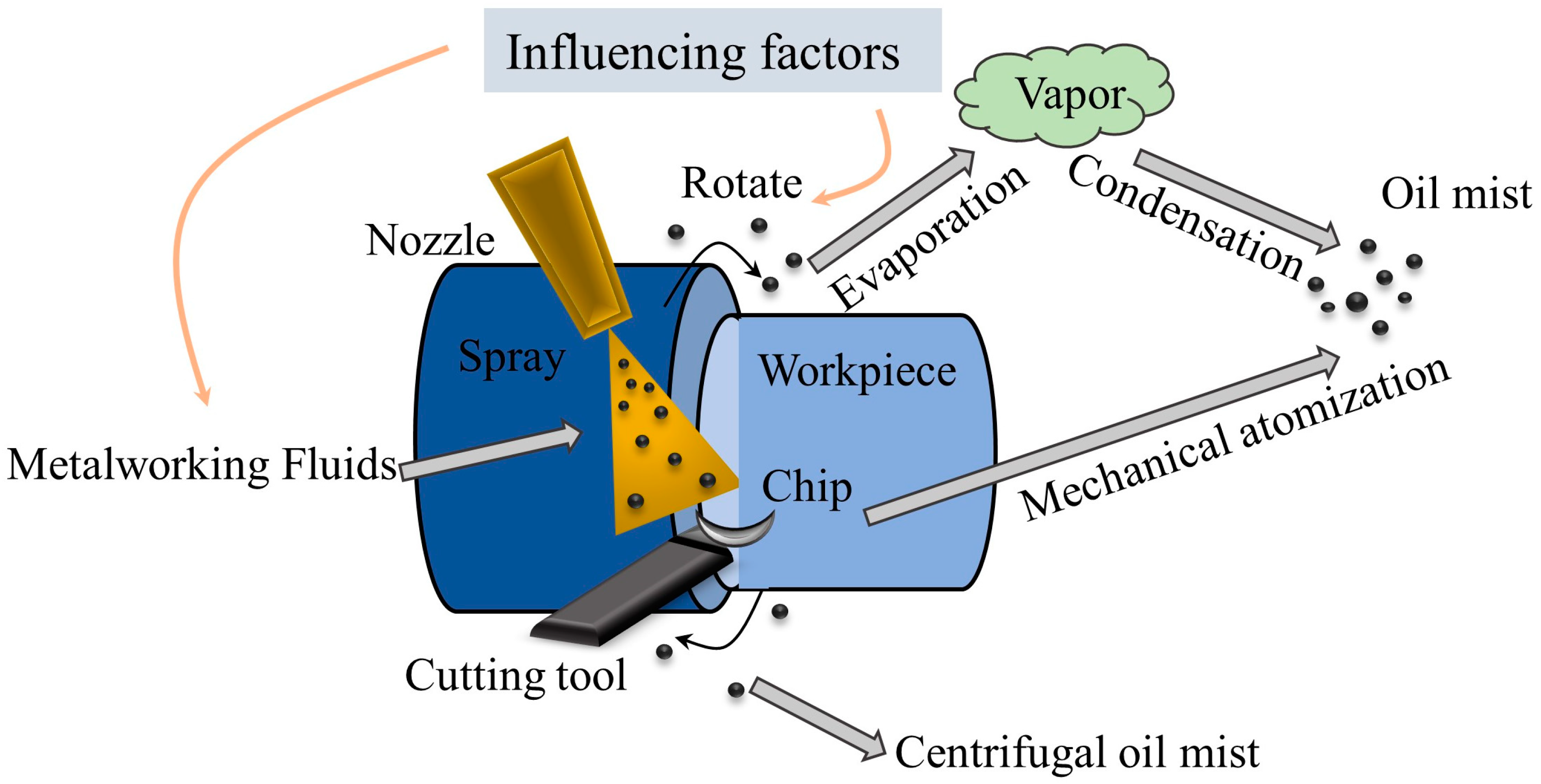



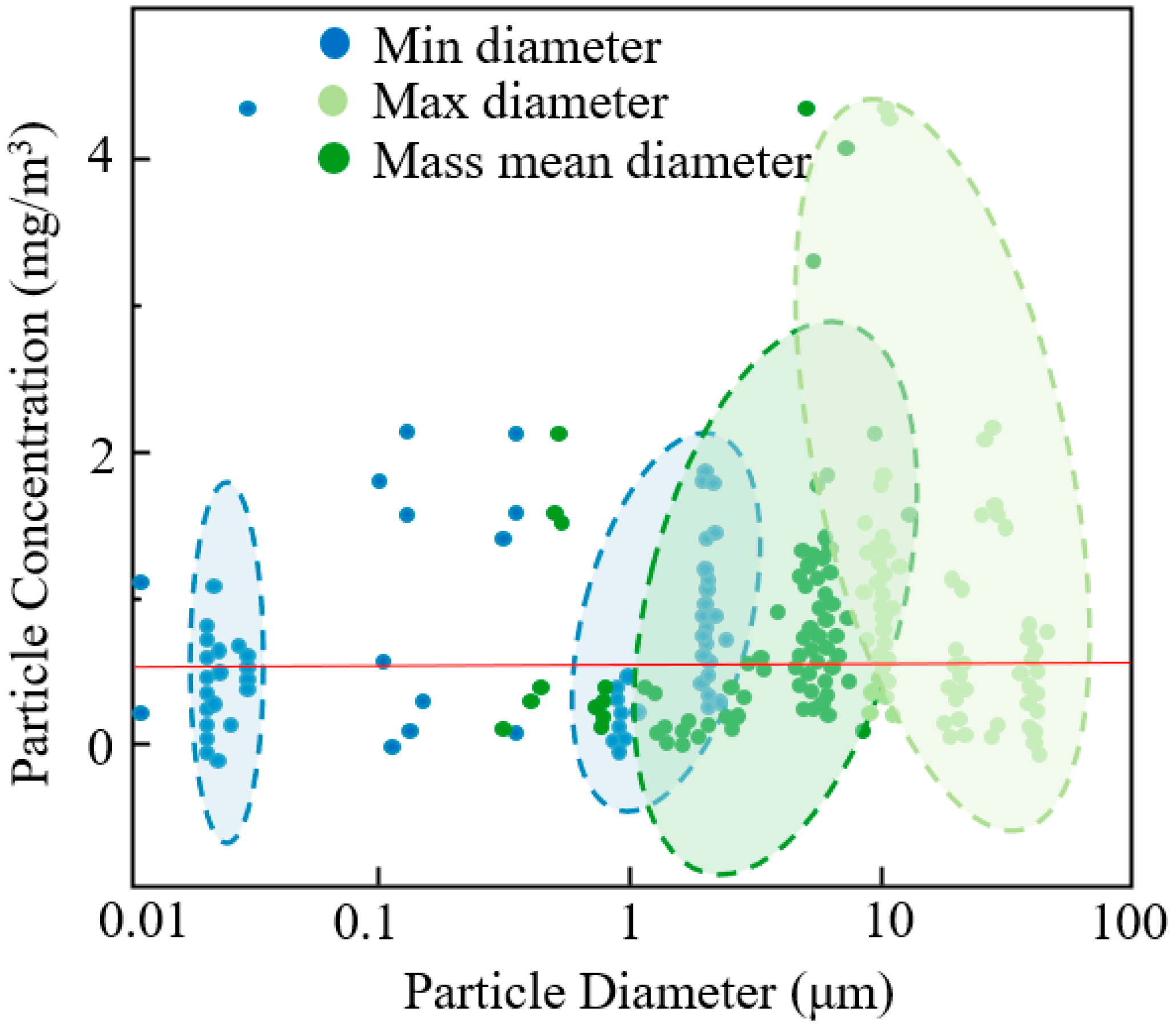
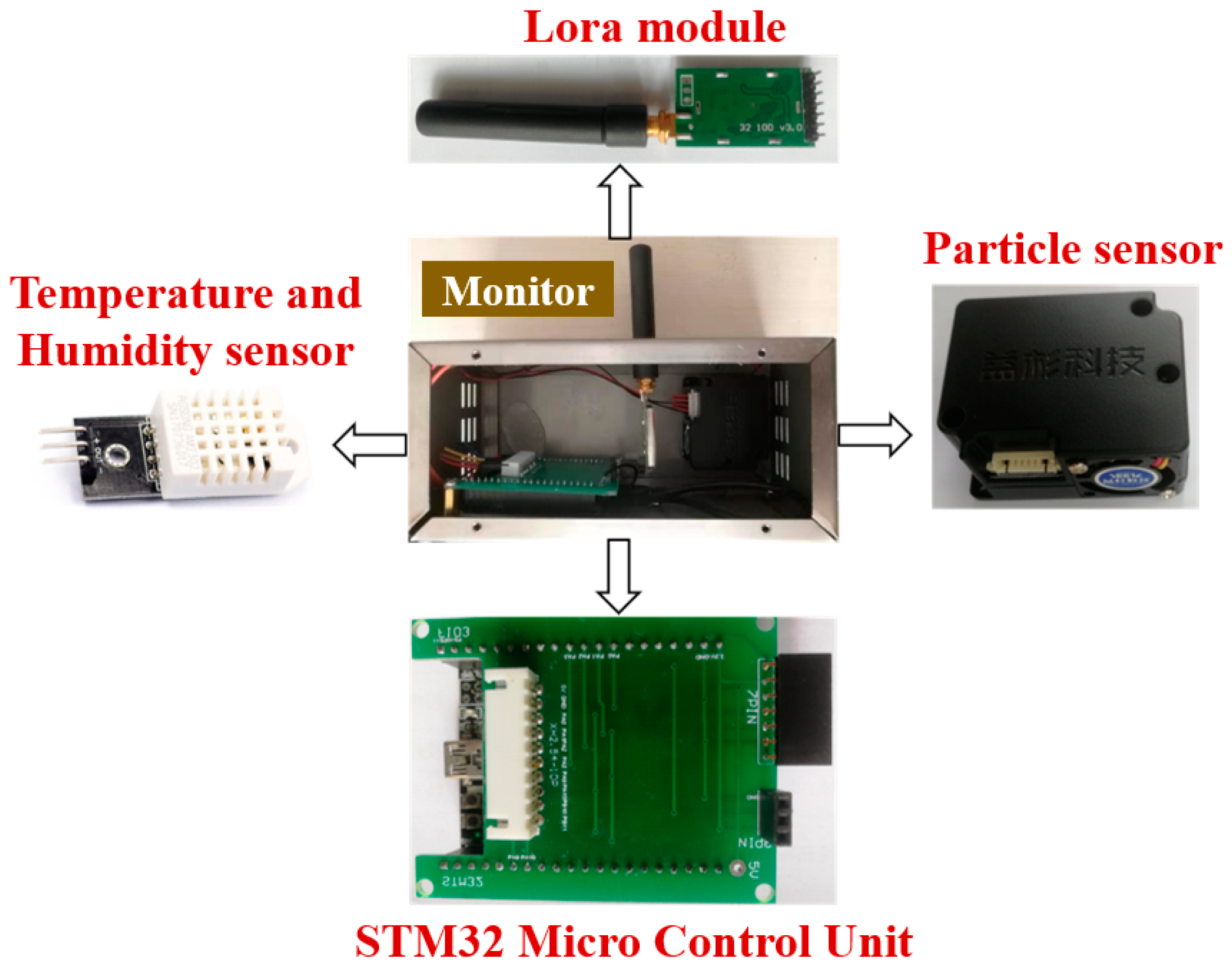

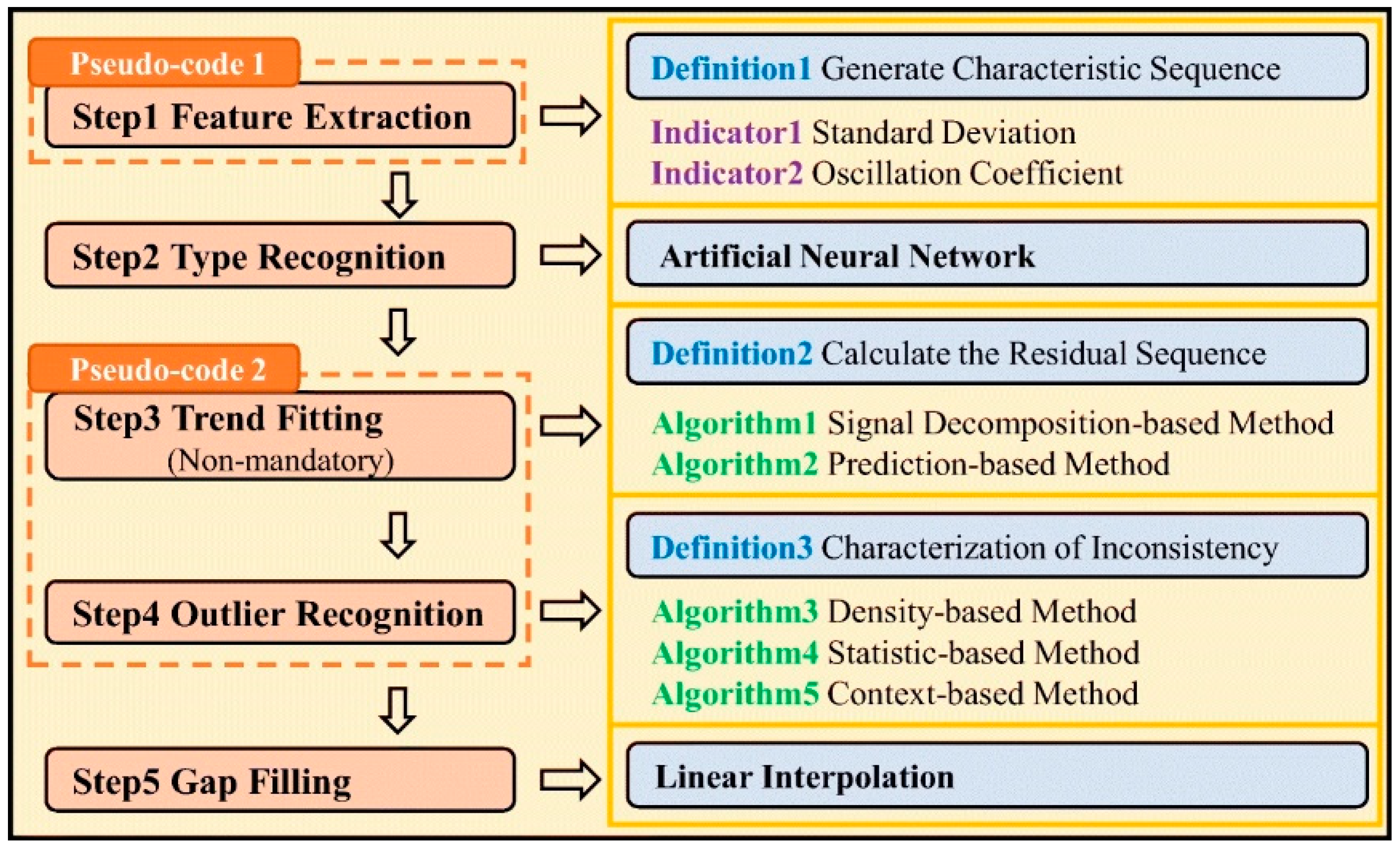
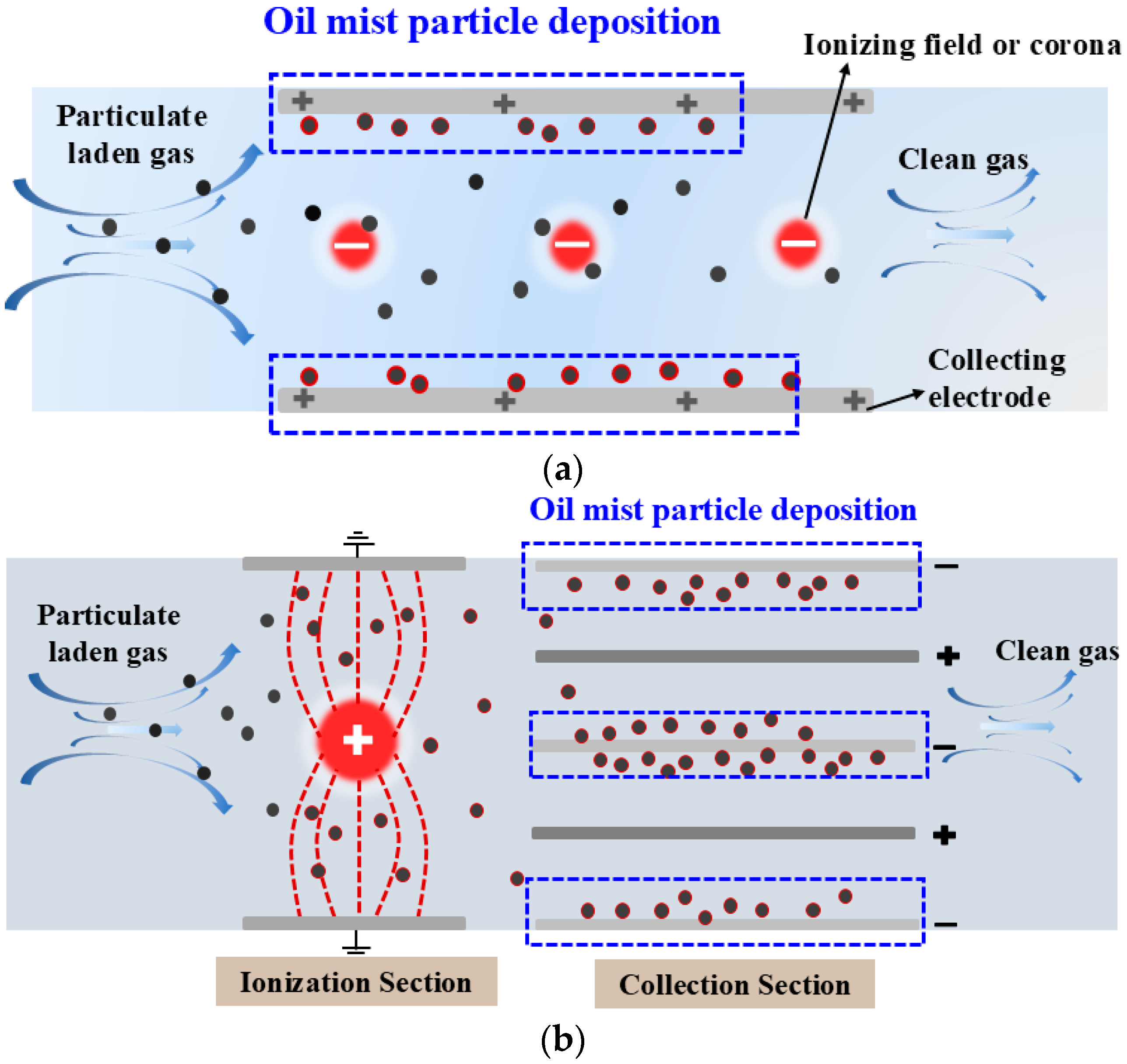

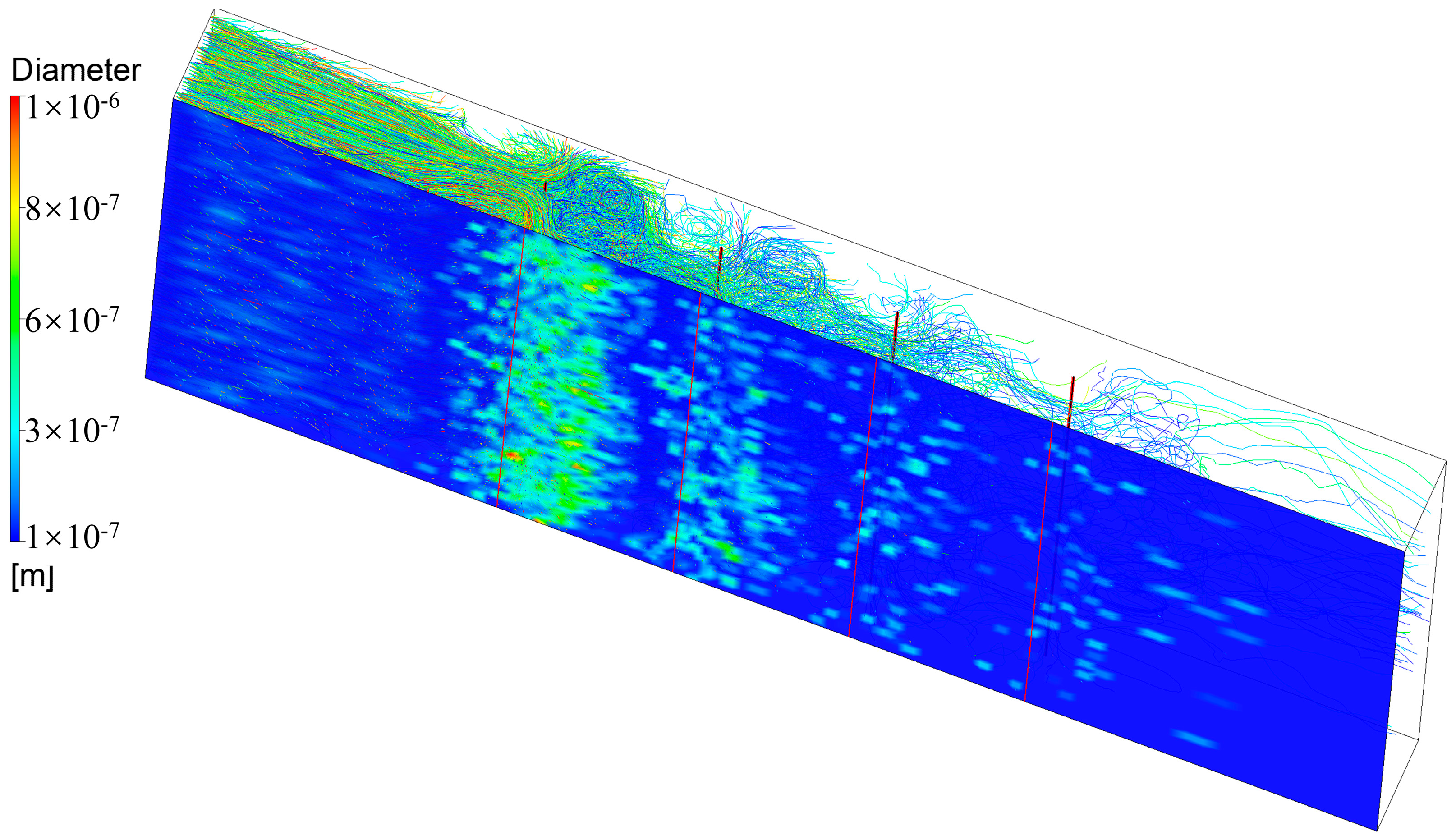


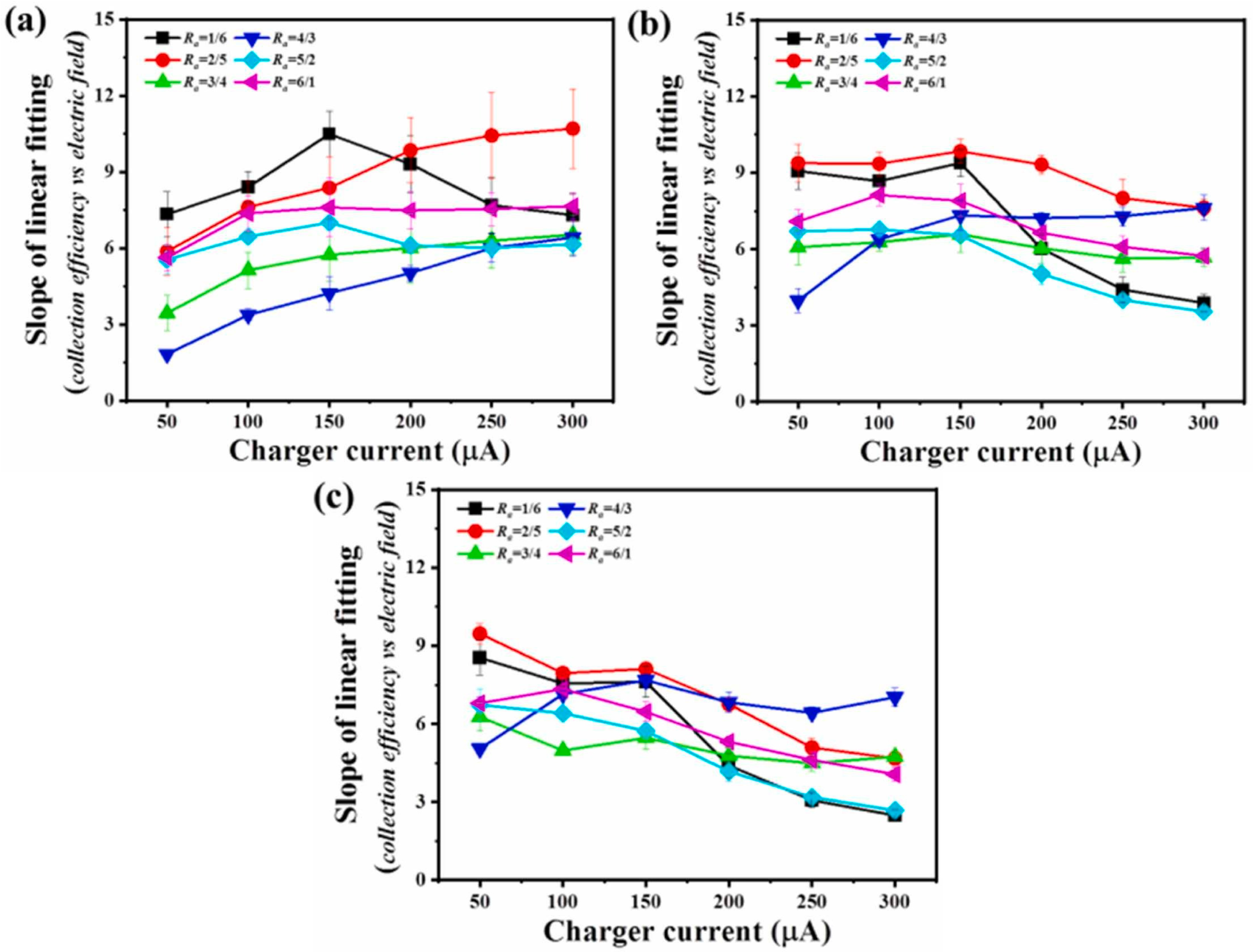
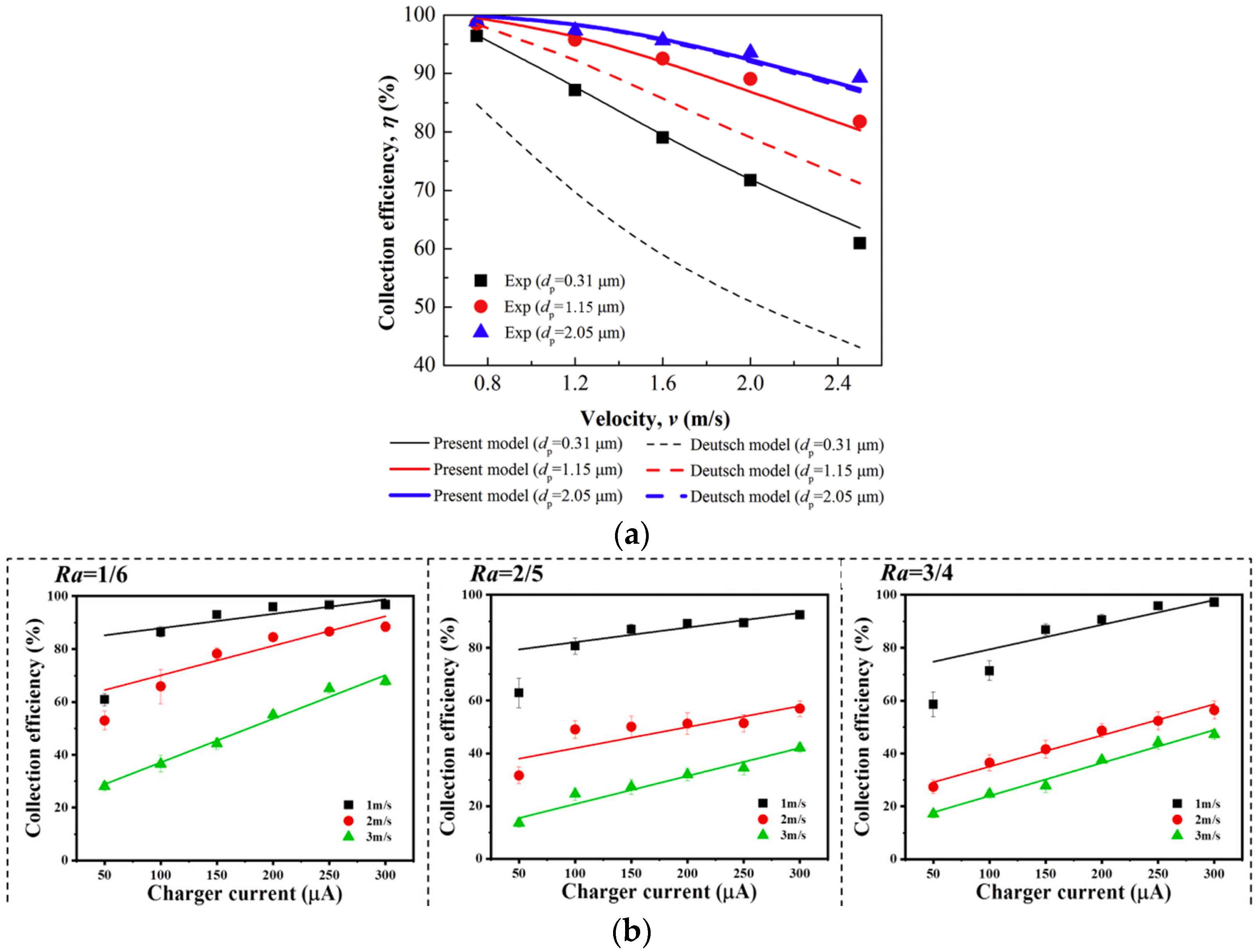
| Exposure Industry | Exposure Concentration (mg/m3) |
|---|---|
| Steelworkers [49] | 0.27–1.6 |
| Cable manufacturing workers (impregnation, sheathing, and installation of paper insulated) [50] | 2.25 |
| Automobile manufacturing workers [51] | 2.6 |
| Ship engine maintenance workers (ferries) [52] | 0.45 |
| Ship engine maintenance workers (overall) [53] | 0.24 |
| Ferries | 0.21 |
| Cargo ships | 0.33 |
| Express ships | 0.44 |
| Tunnel construction workers [54] | 0.070–1.4 |
| Threading workers [55] | 2.11 |
| Forming workers | 1.58 |
| Heat treatment workers | 0.0801 |
| Optimization Parameters | Research Content | |
|---|---|---|
| Zukeran et al. [82] | Airflow velocity | Dust removal efficiency and particle size distribution |
| Dumitran et al. [83] | Electric field strength | Particle migration velocity |
| Huang et al. [84] | Particle size, air velocity, and voltage | Relationship between particle penetration and particle size |
| Al-Shujairi et al. [85] | Airflow velocity and voltage | Dust removal performance |
| Song et al. [86] | Airflow velocity and voltage | Counting efficiency of particles of different sizes |
| Zhou et al. [87] | Airflow velocity, voltage, plate spacing | Total dust removal efficiency |
| Kawada et al. [88] | Ground plate length | Total dust removal efficiency |
| Khaled et al. [89] | Air flow velocity | Corona inception voltage, breakdown voltage, and collection effect |
| Anurag Pal [90] | Voltage | Total dust removal efficiency |
Disclaimer/Publisher’s Note: The statements, opinions and data contained in all publications are solely those of the individual author(s) and contributor(s) and not of MDPI and/or the editor(s). MDPI and/or the editor(s) disclaim responsibility for any injury to people or property resulting from any ideas, methods, instructions or products referred to in the content. |
© 2025 by the authors. Licensee MDPI, Basel, Switzerland. This article is an open access article distributed under the terms and conditions of the Creative Commons Attribution (CC BY) license (https://creativecommons.org/licenses/by/4.0/).
Share and Cite
Liang, L.; Lan, Y.; Yu, T.; Leng, W.; Zhang, L.; Long, Z. A Comprehensive Review of Industrial Workshop Oil Mist Control Technology Based on Electrostatic Collection. Atmosphere 2025, 16, 242. https://doi.org/10.3390/atmos16030242
Liang L, Lan Y, Yu T, Leng W, Zhang L, Long Z. A Comprehensive Review of Industrial Workshop Oil Mist Control Technology Based on Electrostatic Collection. Atmosphere. 2025; 16(3):242. https://doi.org/10.3390/atmos16030242
Chicago/Turabian StyleLiang, Linfeng, Yuer Lan, Tao Yu, Wenjun Leng, Lei Zhang, and Zhengwei Long. 2025. "A Comprehensive Review of Industrial Workshop Oil Mist Control Technology Based on Electrostatic Collection" Atmosphere 16, no. 3: 242. https://doi.org/10.3390/atmos16030242
APA StyleLiang, L., Lan, Y., Yu, T., Leng, W., Zhang, L., & Long, Z. (2025). A Comprehensive Review of Industrial Workshop Oil Mist Control Technology Based on Electrostatic Collection. Atmosphere, 16(3), 242. https://doi.org/10.3390/atmos16030242






